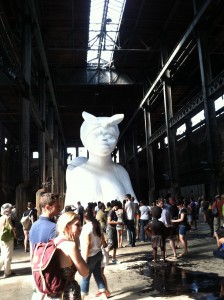Over the past weekend, I made a pilgrimage to see Kara Walker’s A Subtlety before it closed on Sunday at a derelict Domino sugar factory in Brooklyn, New York. The line to get in was eight blocks long, and I had to sign a waiver saying that I would not sue the sponsoring organization, Creative Time, if I happened to get ill from inhaling any of the toxic chemicals that lingered inside the factory. The experience was well worth the effort.

Like the work Walker is best known for, A Subtlety explores this country’s checkered past through sometimes graphic depictions of racial stereotypes. Unlike her well-known work in cut paper silhouettes, A Subtlety explodes in three monumental dimensions in a way that is anything but subtle. At the far end of the factory is a giant “sphinx” made of polystyrene blocks covered in white sugar, standing 35 feet tall. The sphinx is part “Mammy” figure, invoking the antebellum stereotype of a heavyset, un-sexualized black woman responsible for cooking, cleaning, and raising her white master’s kids. At the same time, the sphinx’s breasts, behind, and vulva are all exposed and over-sized, adding the decidedly overly sexualized image of the female black body associated with the “Hottentot Venus” to the mix. The juxtaposition is intentionally contradictory and jarring, and speaks to the way the African American woman has been historically miscast as one of the lowest untouchable classes: either matronly, while caring for children not her own, or an object of “forbidden” sexual desire.

Scattered around the Sphinx are her attendants, sculptures of black boys made out of molasses that were modeled after tchotchkes Walker found on Amazon. They carry baskets, perhaps meant to be filled with sugar cane taken from the fields. They too, have a double meaning as the black male whose body is the site of labor, and the black male as “boy,” infantalized in comparison to the adult white male. Though Walker’s visuals are imposing and impressive, my first impressions to the work were not based on sight, but on smell. As I entered the warehouse space, I was immediately confronted with a smell exactly like the smell one encounters when opening a bag of Domino sugar. However, the more I explored the space, the more I became aware of other, less-pleasing smells–the smell of massive amounts of insecticides used to keep the factory clear of bugs; the rotting smell of the molasses as it decayed in the sunlight that streamed through the windows. This move from sweet to sickly is perhaps as good a metaphor as any for how Walker’s work seduces you with its monumentality, only to have you later examine its entropy and deliberate cracks at the margins. For instance, although the sphinx looks solid and whole from far away, the cracks between the blocks that make it up are clearly visible upon closer inspection. While some works of art appear effortless in construction, one of A Subtlety’s strengths might just be its labored appearance. While walking through the exhibition, I kept thinking of all the people who must have labored under Walker’s guidance to produce the sculptures, casting molasses and assembling the blocks that made up the sphinx–entirely appropriate for a work that is in part about the labor that black men and women did in the fields and the factory to keep the sugar industry booming. As I write this, the fruits of this labor are already coming down. The work was never intended to be permanent, but neither was the Domino sugar plant, which soon will be torn down to make way for a public park. There is a visual pun between the rapidly decaying molasses and the rusting steel girders of the factory warehouse that contains it.

At first, the ephemeral nature troubled me, especially since the lasting effects of racism and sexism that the work highlights are far from temporary. After all, the same racialized “Mammy” figures can still be found easily today, even locally for purchase in the flea market section of the Street of Shops. However, I began to rethink this opinion on the ephemerality of this work as I came to realize that the mammy figure and related images have the same kind of life as A Subtlety–they forcefully explode into our collective consciousness, erode and decay, and are erased only to experience a resurgence in other forms, just as the antebellum tropes of Walker’s sculptures never truly went away after the Civil War. Whether intentional or not, the floor at the exit of the Domino sugar plant is especially coated in sticky molasses, which forced me to linger just a moment longer.

There are other, more intentional ways in which the work will live on. The park around the factory was already becoming an ephemeral discursive space, as community groups used the exhibition to stage impromptu classes and workshops. This discursive space continues in online platforms such as this one, as well as a digital re-creation of the sculpture crowdsourced from visitor photos found here. You can see more photos from our “field trip” on our Instagram and Facebook pages, #karawalkerdomino. Though I do not wish for the racist tropes that Walker boldly reasserts to live on in other forms, I expect this work will be remembered as one of her best. Did you get a chance to check out A Subtlety before it closed? Share your thoughts in the comments below.

